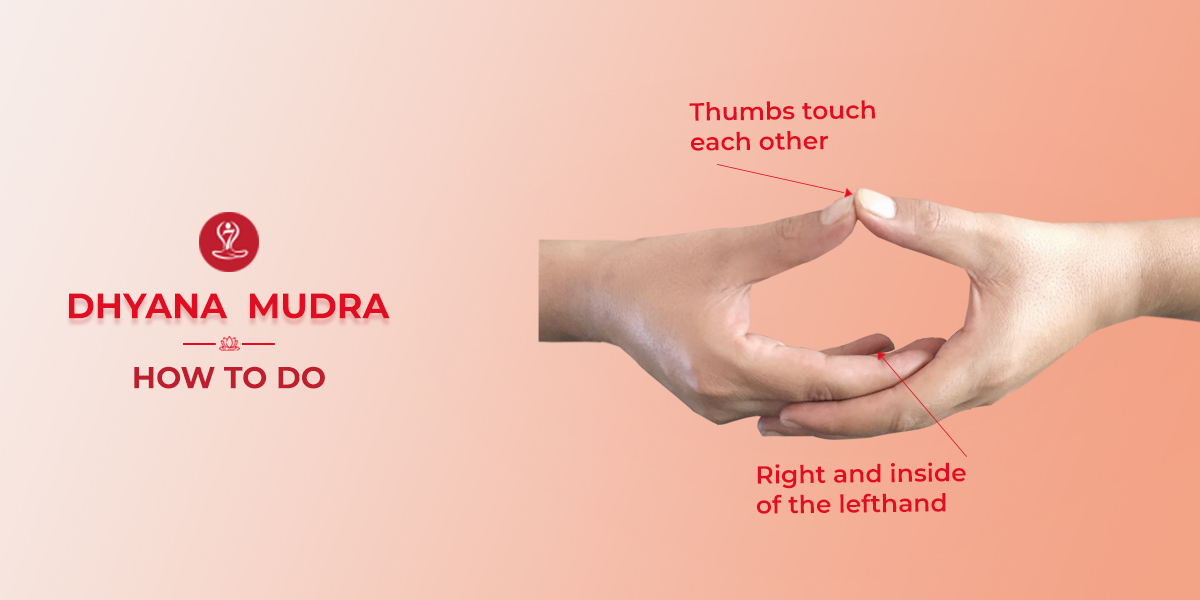Dhyana mudra is the hand gesture usually practice a time of meditation. The benefits of the dhyana mudra are to bring you into more profound concentration.
Suchi Mudra Meaning
The word Dhyana in Sanskrit is made up of two essential parts- Dh Which means “Eclipse or Mind” and Yana which means “moving” or “going”.
Meditation is the most important part of yoga, which requires deep mental concentration. The aim is to remove the mind from the ongoing thoughts and fix it on one point or thought, but it is best to close the eyes and try to look at the mid point of the brow and concentrate the mind. Dhyana Mudra completely purifies the internal nature of the mind and leads to positivity.
Dhyana Mudra is also known as Samadhi Mudra. According to Hinduism, the deity sits in a meditative posture and places the right hand inside the left hand in the lap with the palms facing upwards. This position is known as yoga posture. There is a deep secret hidden in yoga postures.
Steps to do Dhyana Mudra
Dhyana Mudra is associated with the meditation that performing together with deep breathing and meditation asanas. It is a yogic hand gesture that is performed by placing the right hand on the palm of the left hand. the meditation mudra that is created by this is also called Amitabh Dhyana Mudra. For anyone who has to sit for long periods of meditation, this Dhyana is appropriate.
There are some simple steps that will explain how to do this Dhyana Hasta Mudra.
- First of all, sit in any comfortable seating posture and place the hands with palm pointing upwards on the thighs or the knees.
- Sit any sitting pose Vajrasana, Padmasana, Siddhasana, Swastikasana, etc. a posture which you comfortable for sitting 30 minutes.
- The back should be straight, the backbone is in a straight line. Sitting comfortably,
- Do not sit in a posture that causes pain or discomfort and distracts the mind.
- If it is not possible to sit on the ground, then you can sit directly on a chair.
- Close your eyes and take some deep breaths with the awareness of the breathing process.
- Now put together your hands in your lap. Place your right hand inside of your left hand with your palms facing up.
- Shape the bowl of the hands.
- Both thumbs should touch each other, forming a triangle.
- The fingers are extended.
- Your hands should be placed on the level of the stomach or the thighs.
- Removing all thoughts from the mind has to focus the mind only on OM.
- Do not decrease or increase the speed of breath from your side.
You can practice this Mudra by standing in Tadasana Yoga (Mountain pose), otherwise sitting on a chair. Perform this pose for 35 minutes at a stretch every day or for 10 to 12 minutes three times a day.
This mudra is beneficial for the body in many ways, it helps in curing various types of diseases, let us know the benefits of Dhyana mudra in detail.
Benefits of Dhyana Mudra (Gesture Of Meditation)
- Most importantly, Dhyana is not only a means of attainment or salvation of God but it also brings positiveness in your thinking.
- The shape of the triangle made by both thumb, represent the three jewels of Buddhism- Buddha, Sangha (community), Dharma (teachings).
- Dhyana mudra is beneficial for both our body and mind. It releases tension from your body, calms the mind.
- Dhyana increases knowledge. Because whenever you meditate, your memory power increases even more.
- Moreover, this Mudra alerts the flow of life in the body.
- Through this, the Kundalini or source of energy can be awakened.
- When a student regularly practices Dhyana Mudra, it is no less than a boon, it develops memory and increases knowledge, makes one feel like studying.
Time Interval
Bhramar Mudra can be practiced in different positions like standing, sitting or lying down. Whether you choose to practice in the morning, afternoon or evening, the benefits of Bhramara Mudra can still be experienced. Additionally, incorporating silent chanting of mantras or positive affirmations can increase the effectiveness of the mind and body.
Side Effects
While mudras are generally considered safe and beneficial practices, it’s essential to approach them with mindfulness and awareness. Applying excessive pressure or force during mudra practice can be counterproductive, potentially indicating a restless or agitated state of mind.
Conclusion
For sitting meditation, Dhyana Mudra is considered a valuable tool to improve the quality of analysis and healing of the mind.
In Buddhism, it is believed that Dhyana Mudra was practiced by Gautam Buddha during meditation for the process of attaining enlightenment under the Bodhi tree.


